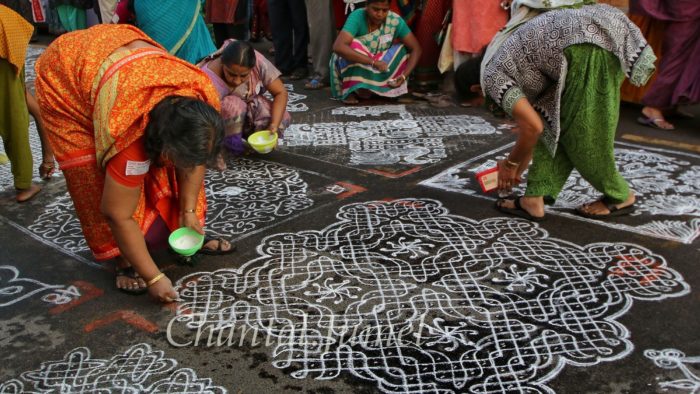The recent Pongal festival saw the lanes of Mylapore in Chennai adorned with kolams of different kinds. The grey asphalt glowed with the white powder, as the transient kolam was protected and celebrated. The very next day the lanes were reclaimed by vendors, residents, motorists, animals; canine and bovine.
The annual kolam competition is over, and kolams return to their simple forms at the thresholds of houses all over South India. Nimble fingers continue to weave pulli kolams every morning, even before day break.
Chantal Jumel, a French national, has authored two books on the sublime floor art - “KŌLAM et KALAM, Peintures rituelles éphémères de l’Inde du Sud” (KŌLAM and KALAM, South Indian ephemeral and ritual paintings), and “VOYAGE DANS L’IMAGINAIRE INDIEN, Kôlam, dessins éphémères des femmes tamoules.”
Here are Chantal’s thoughts on kolams.
How did the kolam cast a spell on a young French graduate from Sorbonne University?
I was brought up in bilingual family. My grandmother was a German. My favourite book was “Contes et légendes de l’Inde” (tales and legends of India), “The River”, a film by Jean Renoir and Siddharta by Herman Hesse, attracted me to India. The alpona that I saw in the movie, The River called me out to India. I wanted to dance like the actress in the movie. On my way to Paris, I met a friend who was going to Kerala and both of us came to Kerala to learn dance. Flying over Kerala, it felt as if I was coming home.

What did you learn in Kerala?
I learnt Mohiniyattam and Kathakali from my Guru, learnt the language, adopted the saree and vegetarian food, and performed the arangetram with the blessings of my Guru Chandramana Govindam Namboodiri in 1982.
While learning Kathakali I observed large pictorial depictions of deities through Kalam, an art form like kolam. In temples of Kerala, a tradition of paintings dedicated to the Gods is prevalent. Unlike kolams these can be seen only in temples or in the courtyards of private homes. It is traditionally done by male artists. M Kurup was my teacher. He would go to temples and houses in order to perform an auspicious ritual called Kalam ezhuthu pattu. I could never master it. I would fill in the folds of the dress of Bhadrakali dress with colour or a large area that needed to be coloured of a different deity.

While learning Kathakali and trying her hand at Kalam another floor art was to bewitch Chantal
What was the pull of kolam?
I learnt the basics of Kolam from a Tamil lady in Kerala. I was intrigued by this whole process of drawing lines outside the home. This was strange as it was the only house to have a kolam, as the other houses belonged to Malayalis and they have no such day to day tradition. Because I was a woman, she taught me kolam so that I too could draw these lines on the threshold of my home!
I was fascinated by the calligraphic beauty of kolams done in the lanes leading to the Shri Padmanabhaswamy temple, Trivandrum and at the Meenakshi temple in Madurai. I asked for a scholarship to document floor paintings in Kerala and I continued with kolam. I came to Chennai to do that.
What appeals to you about the aesthetics of kolams?
The minimalist nature of the lines, like calligraphy, appeal to my sensibilities greatly. I like the firm geometric lines of the Shaivite kolam. But the wavy soft lines of a Vaishnavite kolams also have a quality that is very appealing. It has a certain lashya while the Iyer kolam is more tandava.

Saivite kolam

Vaishnavaite kolam

Sikku kolam
What is the significance of the kolam to you apart from the artistic value?
Apart from the aesthetics, the significance of the kolams lie in what they communicate about the socio-cultural life of a Tamil woman.
Drawing a kolam is a deeply personal exercise. To me it is a written language, a secret language to express or communicate with God which one understands by looking at the symbols. It is like mudras. Mudras are to call the Gods, likewise these kolams call Gods to the threshold.
Besides lines, there are symbols linked to religion and environment, for me it is fabulous. It is only when we look deep into the art that we understand the intricacies of kolam.
Entangled sikku kolam is interpreted differently. I have heard women say that drawing too many sikku kolam leads to family conflicts and conversely women capable of mastering the intricacies of a sikku kolam will be able to sort out difficult situations when they arise at home. The beauty of kolams is that each person will interpret it her way.
These Kolams are not merely an art form they also reveal the socio-cultural- religious beliefs of a community. The straight lines of an Iyer household or the swaying whimsical ones of an Iyengar are a monopoly of none. Anyone can draw a kolam. No one will prevent a woman from drawing. It is Tamil before it is anything else.
Tell us about your kolam lessons.
I am deeply indebted to so many Tamil women who taught me the basics as well as the intricacies of kolam. In my own way I have tried to share their work to a larger group people. Even more interesting has been the interpretation of the kolam. Apart from collecting kolam designs along the lanes of Mylapore or in the villages of Tamil Nadu, year after year, I have learnt to draw also. I may never become as skilled as many of the women I have met but I enjoy assembling dot after dot.
What they finish off in 15 minutes, I take an hour to complete.
One must practice and practice and practice. If you don’t practice for a long time you have to start from zero. I have not mastered kolam. The weather does not allow me to draw regularly outside in France, so I draw on paper.
What is the essence of the kolam to you?
The significance of the kolam lies in its ephemeral nature. The kolam depicts the cycle of life. They are drawn in the morning and wiped out later only to have the same process begin again. To have millions of women wake up every morning to express their culture graphically is beautiful. The design gets completed, ready to welcome the day when it may be blown away by a gust of wind or a monkey may destroy it, or kids may run over it. Kolam’s strength lies in its beauty and frailty. It is such a beautiful spiritual exercise
Is there a higher purpose to this art form for you?
It is an ancient art form that finds mention in many texts. But it is not rigid, everyone draws it differently and everyone is right. People talk of kolams as if there is nothing much in it. But there is something interesting about kolam. Each woman has her own style and her way of relating to the drawing. Some draw it as a sewa (service), some as an expression of devotion, a few may draw it for a pleasure.

Sewa at Ramakrishna Matha
https://chantal-jumel-kolam-kalam.com/en/inspiring-women-maheswari/

A devotee who depicts Krishna every morning
https://chantal-jumel-kolam-kalam.com/en/inspiring-women-ramamani/
I have come across so many different expressions of kolams that I am increasingly of the view that each kolam is a unique art form! These women know how-to carry-on tradition. The ones whom I know are very creative, even though I may not like their work, I appreciate their creativity. Kolams can support any sort of cause whether political or environmental. This is what is so extraordinary about it!
What do you think it signifies to the house in front of which it is drawn?
I believe that a home without a Kolam does not shine. I have seen, documented, photographed kolams on thresholds, in the kitchen and pooja rooms for different days and the repetitive act of drawing them every morning is like renewing yourself every day! The dot, and the line which goes around the dots are like Purusha and Prkriti and therefore convey the image of a balanced world.
Kolams are not confined to the threshold. They are drawn in Pooja rooms at times according to the days of the week. This is an unspoken, one on one communication with the God of the day appealing for its grace.
Women make drawings in front of the stove or write powdered inscriptions in front of the burners or on the kitchen counter so that the goddess can provide abundant food for the family.
How has Kolam drawing and its study helped you?
This world of floor painting has become a source for my own creative world, my own expression on paper. I have made a whole series which I called ‘Tamil Geometry In Kolam’. There is repetition and I love repetition. I love minimalism so it is there in my drawings. Instead of using lines, I use one syllable and draw with it till it becomes something. This is like likhit japa! It becomes a way of concentrating, meditating or reaching God.
Kolams have helped me as my personal source of expression. The repetitive nature of my work frees my imagination to express things about human nature. The monochrome enables abstraction and contemplative silence.

Why don’t you participate in the Mylapore competition?
That’s a good question. I am too shy because I don’t want thousands of eyes on me, but more than that I like to watch, I want to see them draw, I like to report their stories My priority is to talk about this forgotten world of the kolam artist, about the women who are not treated as artists. They deserve attention; kolam deserves attention. In this journey I have travelled all over Tamil Nadu and met many women. A few have become close, especially the older women, are my inspiration. I have written about them, recorded their work and shared it on my you tube channel.
I have been conducting lectures for small group of women in France explaining the aesthetics of kolam, some of them became teary eyed after realising its worth!
I want this art form to get the classical status that it richly deserves. It is a classical art mentioned as Bhoomika Chitra in Vishnudharmottara Purana.
https://chantal-jumel-kolam-kalam.com/fr/
https://chantal-jumel-kolam-kalam.com/en/
https://www.youtube.com/user/paintings1008Kolam
Do you see a change in the way kolams are expressed?
Now women sign their kolam. The impersonal has become personal. Twenty years ago, nobody would sign it. It was impersonal when it was a part of the ritual to decorate the threshold. It had to be put there for the wellbeing of the husband. Now that women are going out, their world has expanded too.

What do you think is the future of this art?
The paramapara of kolam is disappearing. But the tradition will be kept alive in a new form. The kolam will step out of the household. Women will take it to different corners of the world. It will no more be confined to the threshold. Kolam will be carried forward by passionate women who are willing to travel and draw the most beautiful kolams to inspire the younger generation. This is how I think the kolam will live in days to come. My Kolam passionate family called Rangavaali is committed to the cause of kolam and I see a great hope in their work for the future of this art.
(All the photographs are by Ms Chantal Jumel)





